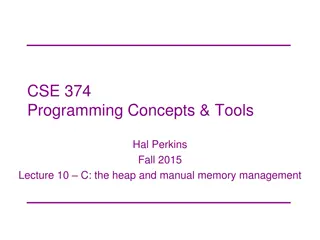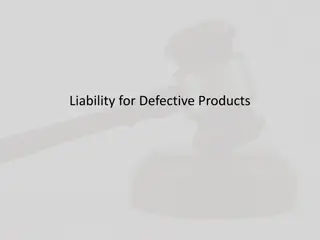
Understanding Antimicrobial Stewardship Programs in Healthcare
Explore the importance of Antimicrobial Stewardship Programs (AMSP) in hospitals, focusing on rational antimicrobial use, compliance monitoring, and implementation strategies. Learn why AMSP is crucial due to antimicrobial resistance and misuse issues. Discover key components like administrative support, AMS team formation, and infrastructure requirements for successful program implementation.
Download Presentation

Please find below an Image/Link to download the presentation.
The content on the website is provided AS IS for your information and personal use only. It may not be sold, licensed, or shared on other websites without obtaining consent from the author. If you encounter any issues during the download, it is possible that the publisher has removed the file from their server.
You are allowed to download the files provided on this website for personal or commercial use, subject to the condition that they are used lawfully. All files are the property of their respective owners.
The content on the website is provided AS IS for your information and personal use only. It may not be sold, licensed, or shared on other websites without obtaining consent from the author.
E N D
Presentation Transcript
Antimicrobial Stewardship Dr. Ved Prakash Professor & Head PG Department of Microbiology
Learning objectives At the end of the session, the students will be able to understand: Implementation of Antimicrobial Stewardship Program Monitoring the Compliance to Antimicrobial Stewardship Program Rational Use of Antimicrobial Agents Hospital Antibiogram 2
Introduction Antimicrobial stewardship program (AMSP) provides strategies for rationalizing the use of antimicrobials in the hospital. 3
Definition CDC has defined Antimicrobial stewardship as- The right antibiotic for the right patient, at the right time, with the right dose, and the right route, causing the least harm to the patient and future patients 4
Why AMSP is Needed? Antimicrobial Resistance (AMR) Misuse and Over-use of Antimicrobials Widespread Use of Antimicrobials in Other Sectors Poor Antimicrobial Research 5
IMPLEMENTATION OF ANTIMICROBIAL STEWARDSHIP PROGRAM Administrative Support (Leadership) Formulating AMS Team Infrastructure Support Framing Antimicrobial Policy Implementing AMS strategies Education and Training 6
Administrative Support (Leadership) Should be publicly committed to the program. Provide necessary funding and infrastructure support. 7
Formulating AMS Team Multidisciplinary committee - responsible for framing, implementing and monitoring the compliance to antimicrobial policy of the hospital. Led by the antimicrobial steward - infectious disease physician or infection control officer or clinical microbiologist. Other members of AMS team - stewardship nurses, clinical pharmacists and officer in-charge of pharmacy. 8
Infrastructure Support Support from Microbiology laboratory Automations: Automated culture (e.g. BACTEC or BacT/ALERT), Automated identification (MALDI-TOF) Automated sensitivity (e.g. VITEK) Biomarkers: Procalcitonin and CRP Rapid Molecular tests Emergency lab 9
Other supports Hospital information System (HIS) Supporting manpower availability 10
Framing Antimicrobial Policy Pocket hand book Prepared by AMS team Compliant to the standard national and international antibiotic guidelines and local antibiogram pattern. 11
Implementing AMS strategies Two types of strategy are available for implanting AMSP. Front end strategies (formulary restriction) Back end strategies (prospective audit and feedback) 12
Proposed formulary restriction Unrestricted antimicrobials Restricted antimicrobials Pharmacy supply of >1 days requires approval by AMS team Colistin Carbapenem Tigecycline Semi restricted antimicrobials Pharmacy supply of >3 days requires prior approval by AMS team Teicoplanin, Vancomycin, Daptomycin, Linezolid, Third and fourth generation cephalosporins Pharmacy supply does not require AMS team approval. prior First & second generation cephalosporins, Cotrimoxazole, Azithromycin, Clarithromycin, Fluoroquinolones 13
Back end strategies (prospective audit and feedback) Difficult to perform, but it is the most effective strategy to implement AMSP. The AMS team goes for stewardship round during which they discuss with the clinical team in detail about the compliance to the antimicrobial policy. Mutually agreed upon constructive discussion between AMS team and clinical team. 14
More labor-intensive. More widely practiced More easily accepted by clinicians Provides a higher opportunity for educating and training the health care professionals Impact is delayed but sustainable 15
Education and Training Continuous education, training, motivation and assessment of the health care providers. 16
MONITORING THE COMPLIANCE TO ANTIMICROBIAL STEWARDSHIP PROGRAM Policy adherence (process indicator) Indicators of prescription and administrative compliance Antibiotic Usage outcome indicator DDDs (Daily Defined Dose) /100 bed days Days of Therapy/100 bed days Antimicrobial resistance outcome indicator- analysed by AMR surveillance Clinical outcome indicators - Morbidity and Mortality Financial outcome indicators 17
Indicators of prescription compliance Percentage of time the empirical antibiotic given, is according to the infective syndrome suspected. Percentage of time the empirical antibiotic is modified to according to antimicrobial susceptibility report. Percentage of time cultures are taken before the start of antibiotics. Percentage of time the choice of SAP given is according to the policy. 18
Indicators of administrative compliance Percentage of time the antibiotic is administrated in correct dose, correct frequency, correct route (IV, oral or infusion) Percentage of time the surgical antimicrobial prophylaxis is administrated in correct dose, correct time and frequency Essentials of Medical Microbiology 19
Calculation of DDDs No. of DDDs = Therapeutic dose (No. of tablets/vials used * gm per tablet/vials) WHO defined DDD of the antimicrobial agent Therefore the number of DDD is calculated as: = (0.75 g dose 7 days/0.5 g DDD) = 10.5 DDDs Example Levofloxacin is administered as 750 mg PO daily for 7 days. The WHO assigned DDD for levofloxacin is 0.5 g. 20
Days of Therapy (DOT) DOT of an antibiotic is the number of days that patient receives at least one dose of that antibiotic. Examples include: -A patient has received meropenem 1 g, twice daily for 3 days; the DOT is 3 -A patient has received meropenem 0.5 g, thrice daily for 3 days; the DOT is 3 -A patient has received meropenem 1 g, twice daily and vancomycin 1g thrice daily for 3 days; the DOT is 3+3=6 21
RATIONAL USE OF ANTIMICROBIAL AGENTS Prescribe Only when Indicated Conditions where antibiotics are not required Diarrhea, URTI, when alternative diagnosis like dengue or chikungunya is suspected, as routine antibiotic prophylaxis Culture of Cultures Antibiotics should be initiated only after sending site- specific cultures 22
Empirical vs Targeted Therapy Empirical therapy should be based on three important elements. Infective syndrome likely to be present Common etiological bacterial agents for that infective syndrome Local antibiogram for those organisms, indicating the AMR pattern. Targeted or pathogen-directed therapy: Empirical therapy should be modified subsequently, based on AST report (escalation or de-escalation) 23
Escalation vs De-escalation Approach For example; In hospital X, the antibiotics given for GNB such as E. coli are ranked according to decreasing order of susceptibility: colistin (rank-1) tigecycline carbapenems piperacillin-tazobactam cefoperazone sulbactam amikacin cefepime ceftazidime cotrimoxazole ceftazidime ciprofloxacin ceftriaxone (lowest rank). Escalation Approach De-escalation Approach 24
Site-specific Antimicrobials: Lungs: Daptomycin is not active at respiratory site(inactivated by surfactants) CSF: Any oral antibiotic, 1st & 2nd gen cephalosporins, tetracyclines, macrolides, quinolones and clindamycin are not active in CSF Urine: Antibiotics such as chloramphenicol, macrolide and clindamycin should be avoided in UTI; as they do not achieve adequate urinary concentrations 25
Avoid Administration Errors- Antimicrobials should be administrated - correct dose (as per the age/body weight), and frequency and duration of therapy. Loading dose: Concentration dependent- aminoglycoside, vancomycin and colistin Infusion: Vancomycin - better when mixed with saline and given as an IV infusion Renal adjustment: Dosage of the nephrotoxic drugs - aminoglycoside, vancomycin, and colistin - adjusted according to the creatinine clearance. 26
RATIONAL USE OF ANTIMICROBIAL AGENTS MIC-guided Therapy AST - performed by DD or by MIC - latter more accurate and reliable. Certain situations - antibiotic treatment is MIC-guided. Clinical conditions - endocarditis, pneumococcal meningitis/pneumonia Vancomycin for S. aureus: Vancomycin avoided if MIC is >1 g/mL. 27
MIC helps to select the most appropriate antibiotic: Lower - MIC, better - therapeutic efficacy. If >1 antimicrobial agents susceptible - antibiotic having lowest MIC (when compared with the susceptibility breakpoint) - chosen for therapy. Better guided by calculating the therapeutic index. 28
Therapeutic index Ratio of susceptibility breakpoint divided by MIC of the test isolate. Therapeutic index= Susceptible breakpoint/Test MIC Higher the therapeutic index, better is the efficacy of the antimicrobial agent. 29
Therapeutic index For example, if a clinical isolate of E.coli is susceptible to both meropenem (MIC 1 g/ml) and amikacin (MIC 8 g/ml), then meropenem falsely appears to be more efficacious as its absolute MIC value is lower than amikacin. However, the MIC value compared with the standard susceptibility breakpoint (and not the absolute MIC value) determines therapeutic efficacy. 30
Therapeutic index Susceptible breakpoints of meropenem and amikacin for E.coli are 1 g/mL and 16 g/mL respectively, according to CLSI guideline 2020. The therapeutic index is calculated as: Therapeutic index of meropenem= 1/1=1 Therapeutic index of meropenem= 16/8=2 Therefore, in this case amikacin is superior to meropenem. 31
Therapeutic Drug Monitoring Therapeutic efficacy - not only relies on in vitro susceptibility result (MIC), but also dependent on in vivo activity - in turn dependent on PK/PD parameters of the antimicrobial agent. Therapeutic drug monitoring - necessary to find out how the drug behaves in vivo - important for antibiotic - vancomycin, amikacin and colistin. 32
Depending up on PK/PD parameters, antibiotics are classified as: Concentration dependent antibiotics, e.g. aminoglycosides (better if the drug concentration in serum is much higher than the MIC of the drug) Time-dependent antibiotics, e.g. beta-lactams: Efficacy of the drug is dependent upon how much time the drug concentration remains higher than the MIC. Given in frequent intervals (e.g. thrice daily) 33
Timely Stoppage of Antimicrobial- stopped at appropriate time - determined by clinical improvement or after obtaining negative culture or by use of biomarkers. 34
Biomarkers - procalcitonin (PCT) or C-reactive protein (CRP) - used for predicting bacterial infection. PCT is more reliable marker than CRP. 35
Procalcitonin (PCT) Peptide precursor of the hormone calcitonin, secreted at very low level (<0.05 ng/mL) normally by the body, but the level goes up by manifolds in bacterial infection. 36
Differentiate bacterial vs viral infection Predicting bacterial infections such as local or systemic infection 0.05 2.0 ng/mL indicates possible local infection 2-10 ng/mL indicates systemic infection >10 ng/mL indicates septic shock Helps to decide whether to continue antibiotics in culture negative cases and to stop antibiotics Severity 37
Avoid overlapping spectra Meropenem and piptaz combination therapy for double GN coverage - avoided as both these drugs belong to beta-lactam group of antimicrobials 38
Redundant antibiotic Meropenem and metronidazole combination therapy for suspected GN/ anaerobic sepsis - avoided as meropenem is active against anaerobes in addition to gram-negative bacteria. Metronidazole can be withdrawn from therapy 39
Ineffective antibiotic: Cloxacillin in MRSA is ineffective and therefore should be avoided. Vancomycin is the drug of choice for MRSA Inferior antibiotic: Vancomycin is an inferior cell wall acting agent compared to cloxacillin for MSSA infection. 40
HOSPITAL ANTIBIOGRAM Overall profile of antimicrobial susceptibility testing results of a specific microorganism to a battery of antimicrobial agents. Responsibility of the department of Microbiology to construct ahospital antibiogram and share it with clinicians 41
HOSPITAL ANTIBIOGRAM - USES Guide the clinicians in selecting the best empirical antimicrobial treatment in the event of pending microbiology culture and susceptibility results. Detecting and monitoring trends in antimicrobial resistance within the hospital Compare susceptibility rates across institutions and track resistance trends and thereby contributing to national AMR surveillance database. 42
Hospital antibiogram of gram-negative bacteria for the year 2020, expressed in terms of susceptibility rate Piperacillin- tazobactam Ciprofloxacin Amikacin Ceftazidime Meropenem Colistin E. coli 25 85 55 75 82 99 Klebsiella 15 75 35 65 70 85 Pseudomonas 32 80 60 80 80 99 Acinetobacter 29 70 10 18 20 99 43







